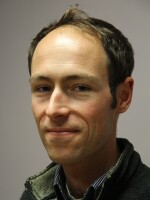ARI SHAPIRO, HOST:
Forests in national parks provide a green oasis for visitors and residents and essential habitats for wildlife. Many of those forests are at risk even though they're protected. From member station WAMU here in Washington, Jacob Fenston has this story about what's going wrong in these ecosystems and what people are doing to reverse the trend.
JACOB FENSTON, BYLINE: On a wooded hillside in a residential neighborhood, Nathan Harrington is sawing away at thick vines of English ivy encircling the trunk of a red oak tree.
NATHAN HARRINGTON: So a lot of people find this very difficult and tedious. But I've had 10 years of practice, refined my technique. And I find it very satisfying.
FENSTON: Harrington is director of the nonprofit Ward 8 Woods Conservancy. This small patch of forest in D.C. is on national park land. Just about every tree has invasive vines climbing the trunk. Some you can't even see the tree bark. He estimates that without this sort of intensive and sweaty intervention, this little forest patch would disappear within a few decades.
HARRINGTON: Just because an area has been wooded for a long time doesn't mean that we can take it for granted and assume that it's always going to stay that way. If we don't go in and maintain it, it will cease to be at some point.
FENSTON: In forests in the eastern U.S., it can be easy to miss the fact that things are going awry. Liz Matthews is a biologist with the National Park Service.
LIZ MATTHEWS: This forest looks healthy perhaps on a quick look, but if you look behind you, you see a tree that has fallen, cracked in half and fallen.
FENSTON: To see how an eastern deciduous forest is doing, don't look up at the mature trees. Look down at the ground. That's where you'll find the next generation of the forest. That up-and-coming generation is in big trouble. To understand why, you have to understand how eastern forests regenerate. Matthews authored a study looking at forest regeneration in national parks up and down the East Coast. Using 12 years of data, they put each park into one of four categories, ranging from secure to imminent failure.
MATTHEWS: Seventy percent of the parks we looked at were either an imminent failure or probable failure.
FENSTON: How many were secure?
MATTHEWS: One.
FENSTON: That was Acadia National Park in Maine. The good news is, despite the huge scale and scope of the problem, the causes are pretty straightforward. Some of the pioneers trying out solutions are at Catoctin Mountain Park in Maryland.
LINDSEY DONALDSON: Catoctin's resource managers began to notice that the park had a lack of forest regeneration back in the 1970s.
FENSTON: The park's Lindsey Donaldson. Catoctin staff suspected a culprit - too many deer.
DONALDSON: Research has shown that vegetation damage occurs when deer populations exceed 20 per square mile, and Catoctin once had 123 deer per square mile.
FENSTON: White-tailed deer are a native species, but when there are too many deer, they devour baby trees. Catoctin was the first national park in the area to cull deer starting in 2010. The results have been encouraging. The deer population is now about one-sixth of what it was, and there are almost 20 times as many tree seedlings per acre. When deer devour native plants, they also make space for invasives to grow.
KATHY SYKES: Raise your hand if you need gloves right now.
FENSTON: On a rainy Sunday morning, a group of volunteers is heading into the woods to pull invasive vines and bushes. Kathy Sykes is leading the group, organized by Rock Creek Conservancy in D.C.
SYKES: Our No. 1 priority is trees. So, like, straight ahead there, it looks like they've sort of...
FENSTON: Invasives often grow in thick mats, crowding out and smothering native seedlings. When a gap in the canopy opens up, invasives rush in and soak up the sunlight. But here, in this part of the forest, volunteers have made a big dent in the problem. Danna McCormick is here most weekends and says she can see a big difference since she started volunteering a couple years ago.
DANNA MCCORMICK: In two years, we are tipping the scale in our favor.
FENSTON: For NPR News, I'm Jacob Fenston.
(SOUNDBITE OF MUSIC) Transcript provided by NPR, Copyright NPR.
NPR transcripts are created on a rush deadline by an NPR contractor. This text may not be in its final form and may be updated or revised in the future. Accuracy and availability may vary. The authoritative record of NPR’s programming is the audio record.



